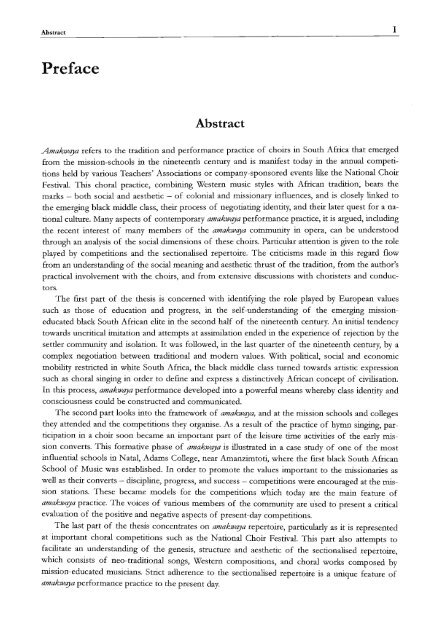South African Choral Music (Amakwaya): Song, Contest and the ...
South African Choral Music (Amakwaya): Song, Contest and the ...
South African Choral Music (Amakwaya): Song, Contest and the ...
You also want an ePaper? Increase the reach of your titles
YUMPU automatically turns print PDFs into web optimized ePapers that Google loves.
Abstract<br />
Preface<br />
Abstract<br />
Amakwqya refers to <strong>the</strong> tradition <strong>and</strong> performance practice of choirs in <strong>South</strong> Africa that emerged<br />
from <strong>the</strong> mission-schools in <strong>the</strong> nineteenth century <strong>and</strong> is manifest today in <strong>the</strong> annual competitions<br />
held by various Teachers' Associations or company-sponsored events like <strong>the</strong> National Choir<br />
Festival. This choral practice, combining Western music styles with <strong>African</strong> tradition, bears <strong>the</strong><br />
marks - both social <strong>and</strong> aes<strong>the</strong>tic - of colonial <strong>and</strong> missionary influences, <strong>and</strong> is closely linked to<br />
<strong>the</strong> emerging black middle class, <strong>the</strong>ir process of negotiating identity, <strong>and</strong> <strong>the</strong>ir later quest for a national<br />
culture. Many aspects of contemporary amakwqya performance practice, it is argued, including<br />
<strong>the</strong> recent interest of many members of <strong>the</strong> amakwqya community in opera, can be understood<br />
through an analysis of <strong>the</strong> social dimensions of <strong>the</strong>se choirs. Particular attention is given to <strong>the</strong> role<br />
played by competitions <strong>and</strong> <strong>the</strong> sectionalised repertoire. The criticisms made in this regard flow<br />
from an underst<strong>and</strong>ing of <strong>the</strong> social meaning <strong>and</strong> aes<strong>the</strong>tic thrust of <strong>the</strong> tradition, from <strong>the</strong> author's<br />
practical involvement with <strong>the</strong> choirs, <strong>and</strong> from extensive discussions with choristers <strong>and</strong> conductors.<br />
The first part of <strong>the</strong> <strong>the</strong>sis is concerned with identifying <strong>the</strong> role played by European values<br />
such as those of education <strong>and</strong> progress, in <strong>the</strong> self-underst<strong>and</strong>ing of <strong>the</strong> emerging missioneducated<br />
black <strong>South</strong> <strong>African</strong> elite in <strong>the</strong> second half of <strong>the</strong> nineteenth century. An initial tendency<br />
towards uncritical imitation <strong>and</strong> attempts at assimilation ended in <strong>the</strong> experience of rejection by <strong>the</strong><br />
settler community <strong>and</strong> isolation. It was followed, in <strong>the</strong> last quarter of <strong>the</strong> nineteenth century, by a<br />
complex negotiation between traditional <strong>and</strong> modern values. With political, social <strong>and</strong> economic<br />
mobility restricted in white <strong>South</strong> Africa, <strong>the</strong> black middle class turned towards artistic expression<br />
such as choral singing in order to define <strong>and</strong> express a distinctively <strong>African</strong> concept of civilisation.<br />
In this process, amakwqya performance developed into a powerful means whereby class identity <strong>and</strong><br />
consciousness could be constructed <strong>and</strong> communicated.<br />
The second part looks into <strong>the</strong> framework of amakwqya, <strong>and</strong> at <strong>the</strong> mission schools <strong>and</strong> colleges<br />
<strong>the</strong>y attended <strong>and</strong> <strong>the</strong> competitions <strong>the</strong>y organise. As a result of <strong>the</strong> practice of hymn singing, participation<br />
in a choir soon became an important part of <strong>the</strong> leisure time activities of <strong>the</strong> early mission<br />
converts. This formative phase of amakwqya is illustrated in a case study of one of <strong>the</strong> most<br />
influential schools in Natal, Adams College, near Amanzimtoti, where <strong>the</strong> first black <strong>South</strong> <strong>African</strong><br />
School of <strong>Music</strong> was established. In order to promote <strong>the</strong> values important to <strong>the</strong> missionaries as<br />
well as <strong>the</strong>ir converts - discipline, progress, <strong>and</strong> success - competitions were encouraged at <strong>the</strong> mission<br />
stations. These became models for <strong>the</strong> competitions which today are <strong>the</strong> main feature of<br />
amakwqya practice. The voices of various members of <strong>the</strong> community are used to present a critical<br />
evaluation of <strong>the</strong> positive <strong>and</strong> negative aspects of present-day competitions.<br />
The last part of <strong>the</strong> <strong>the</strong>sis concentrates on amakwqya repertoire, particularly as it is represented<br />
at important choral competitions such as <strong>the</strong> National Choir Festival. This part also attempts to<br />
facilitate an underst<strong>and</strong>ing of <strong>the</strong> genesis, structure <strong>and</strong> aes<strong>the</strong>tic of <strong>the</strong> sectionalised repertoire,<br />
which consists of neo-traditional songs, Western compositions, <strong>and</strong> choral works composed by<br />
mission-educated musicians. Strict adherence to <strong>the</strong> sectionalised repertoire is a unique feature of<br />
amakwqya performance practice to <strong>the</strong> present day.<br />
I

















